Cozy up with a piping hot bowl of hearty Miso Soup with Yuzu Kosho. Japanese citrus pepper paste adds a refreshing, spicy kick and pairs wonderfully with this soup packed with pork belly and vegetables. {Vegan adaptable}

Soups are ideal for serving nutrient-dense foods that nourish our bodies. That is why the Japanese drink a warm bowl of miso soup almost every single day. There are many versions of miso soup one can make at home, but this Miso Soup with Yuzu Kosho is everything my family and I desire for dinner at home. Simmered in a dashi broth, it’s deliciously layered with pork belly, shiitake mushrooms, sweet cabbage, carrots, leek, and tofu, and lightly spiced with a very special condiment – yuzu kosho.
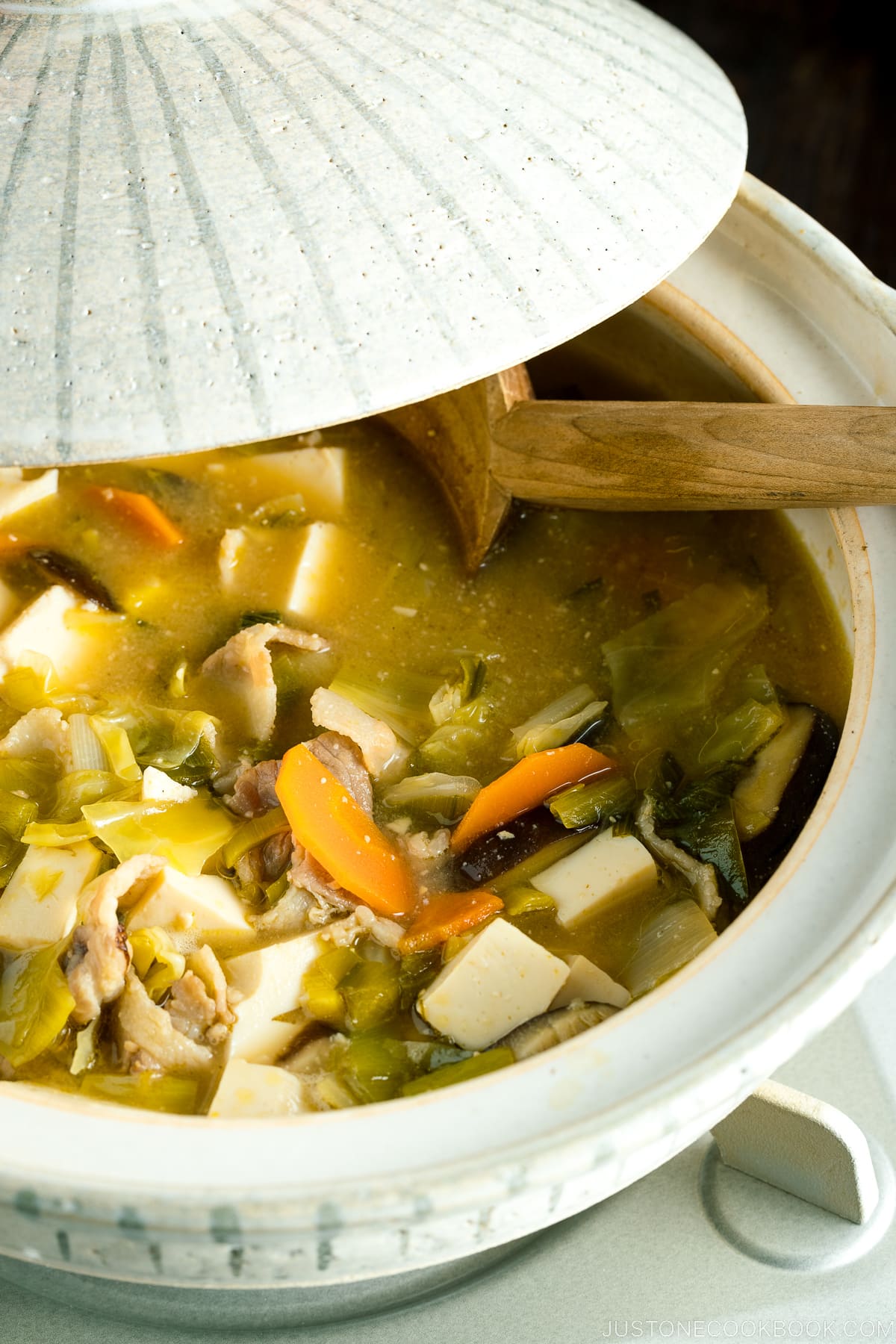
Miso Soup with Yuzu Kosho
I remember vividly when I first tried miso soup that was flavored with yuzu kosho. It was at a breakfast setting at a Japanese ryokan in Kurokawa Onsen, Kyushu (read here). The lady who served our hot breakfast told me to add in yuzu kosho to the miso soup. I thought I’ve heard her wrong and found myself repeating after her “yuzu kosho in miso soup?”, but only with a highly dubious face. She smiled and gave me some reaffirmation nods.
Now, while I enjoy using yuzu kosho to season meat or to flavor yakitori and other dishes, I’ve never heard of seasoning miso soup with yuzu kosho. Curiously, I took the lady’s advice and gave it a try. I first drank the miso soup as it was, and it was delicious, then I added a tiny bit of yuzu kosho to my soup and drank it again. Wow…I was blown away instantly!
Watching my deep satisfaction, Mr. JOC followed suit and added some yuzu kosho into his miso soup. Needless to say, he too was taken by how insanely delicious this little pepper paste did to the soup. We both happily drank up our soup and asked for okawari (second serving). The lady was so happy to see how amazed we were and she kept asking if we want another okawari.
Citrusy, slightly spicy, slightly salty but incredibly aromatic, who would have thought this condiment can add so much more punch to the everyday soup that I’ve been drinking all my life. I would never forget my first taste. Since we returned home to the States, we’ve been enjoying our miso soup with yuzu kosho frequently and we’ve been telling our friends and family about this little new discovery, and I would love for you to try it too.
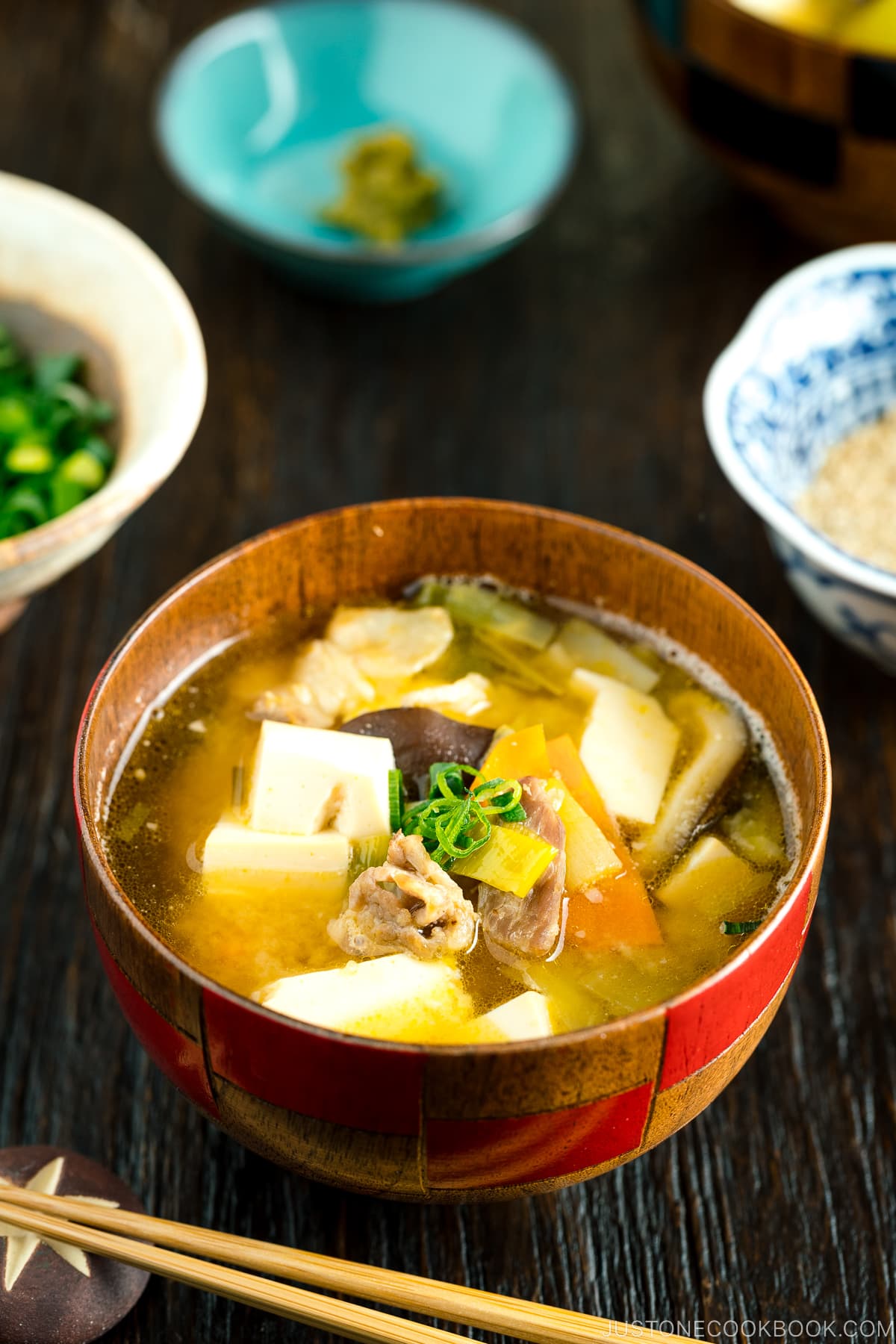
What’s Yuzu Kosho?
Yuzu kosho is still a relatively unknown condiment to most outside of Japan, but when I was recently Google Trends searching Yuzu Kosho, I was surprised to see it actually has a higher result than the direct translation of “yuzu pepper”. I think many Japanese restaurants are using Yuzu Kosho on their menus these days, and many customers are probably searching it on their phone while trying to decide what to order.
So what is yuzu kosho? Yuzu is a winter citrus that’s used in Japanese cooking. It has a flavor somewhere between a lemon, mandarin orange, and grapefruit! It looks like this, and I have used this citrus to make Yuzu Sorbet. Yuzu kosho is simply a paste made from chili peppers, yuzu peel (when it’s still green), and salt. It is then allowed to ferment to bring out the flavors even stronger.
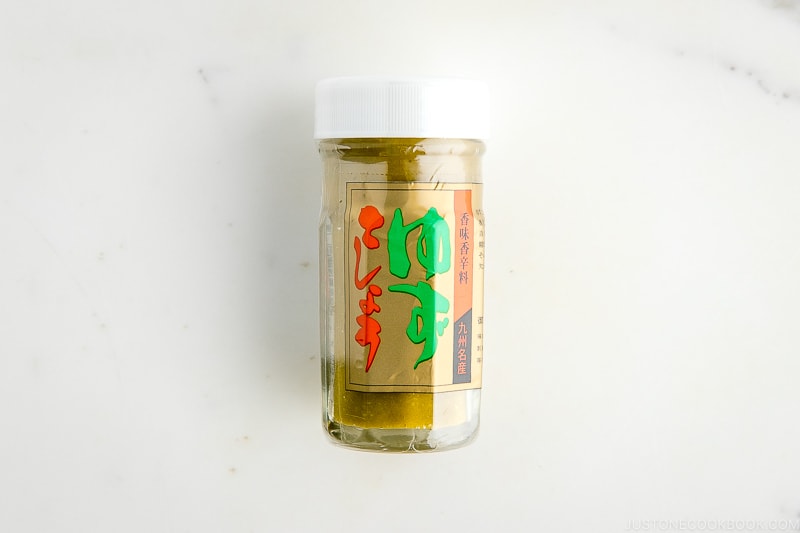
The best yuzu kosho is the one pictured above. It comes in a jar and costs about $8-9. You can find it in the spice aisle (where they carry wasabi, karashi mustard, shichimi togarashi, etc) at Japanese grocery stores. You can also find a different brands on Amazon.

Substitutions and Variations
Miso soup is all about customization. If you couldn’t find thinly sliced pork belly, that’s okay. You can leave it out. Just know that pork belly is not bacon; it’s the same cut as bacon but it is fresh/raw and not cured like bacon. Not a fan of mushrooms or tofu? That’s okay too.
You can make a vegetarian/vegan version with kombu dashi (just leave out katsuobushi) and add in lots of vegetables. You can add pretty much any vegetable in your miso soup, even though they may not be the typical Japanese options. If you only have kale in your hands, of course, you can throw in some kale in your miso soup. Just because we don’t use kale in Japanese food, it doesn’t mean we can’t have miso soup with kale.
If you’re not sure with your selection of vegetables, leave a comment below and I’ll see if it’s a good match.
Whether you’re making regular or vegetarian miso soup, you must use dashi for the soup broth. Do not substitute with chicken broth or water because dashi is the only ingredient that makes miso soup taste authentically Japanese.
If you love miso soup, I hope I’ve convinced you to add a jar of yuzu kosho to your pantry so you can have your miso soup with this amazing pepper paste. The spicy, citrusy and aromatic flavors of the condiment really do the trick to elevate the bowl of soup and everything just taste a whole lot more delicious.
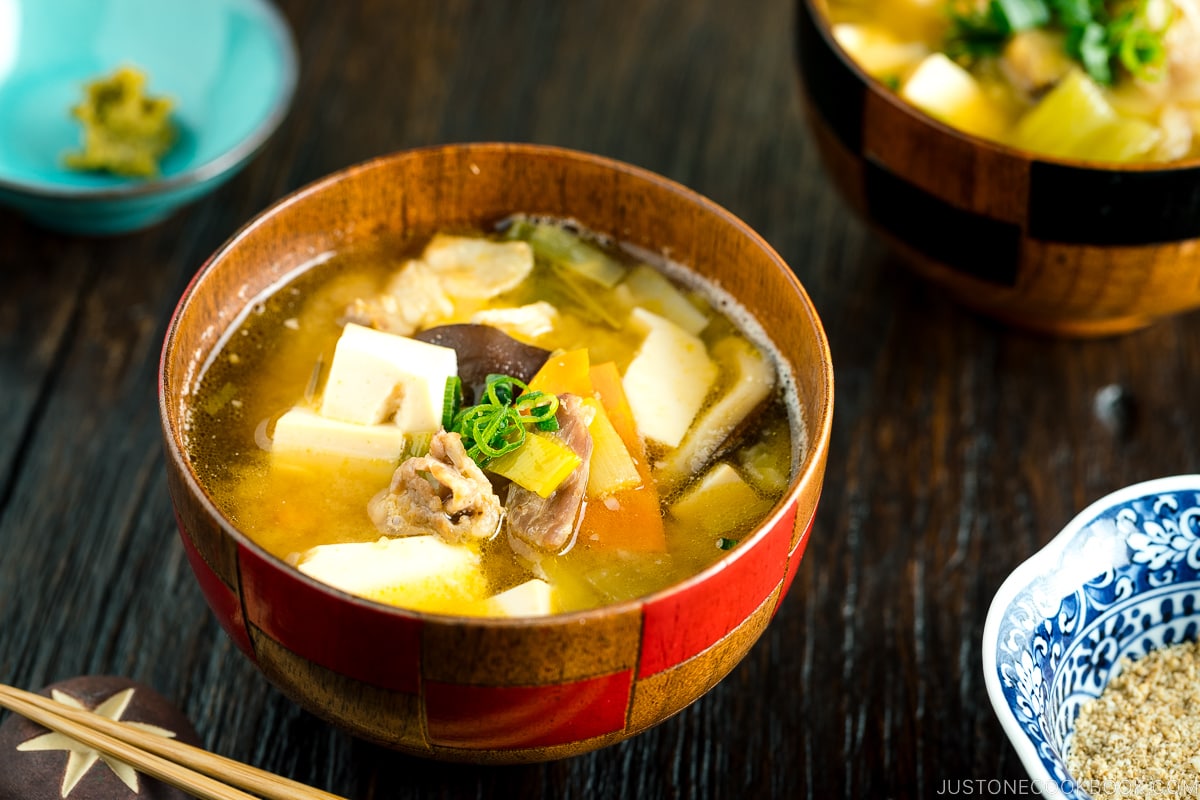
Wish to learn more about Japanese cooking? Sign up for our free newsletter to receive cooking tips & recipe updates! And stay in touch with me on Facebook, Pinterest, YouTube, and Instagram.

Miso Soup with Yuzu Kosho
Video
Ingredients
- ¼ lb sliced pork belly (4 oz; skip for vegan/vegetarian)
- 1 leek
- 2 leaves green cabbage
- 4 pieces shiitake mushrooms
- 2.5 oz carrot (1½ inches, 3.8 cm)
- 2 green onions/scallions
- 1 Tbsp toasted sesame oil
- 1 Tbsp sake
- 4 Tbsp miso
- 14 oz soft/silken tofu (kinugoshi dofu) (1 block, cut into cubes)
- yuzu kosho (Japanese citrus chili paste) (to taste)
- 2 Tbsp toasted white sesame seeds
For the Dashi
- 4 cups water (for standard Awase Dashi; you can also use a dashi packet or powder; skip the katsuobushi for Vegan Dashi)
- 1 piece kombu (dried kelp) (3 x 4 inches, 7.5 x 10 cm per piece)
- 3 cups katsuobushi (dried bonito flakes) (skip for vegan/vegetarian)
Instructions
- Gather all the ingredients.
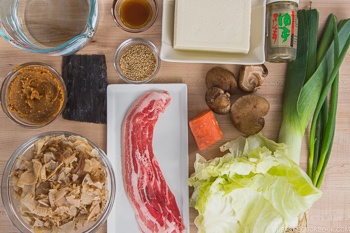
To Start the Dashi
- In a measuring cup (or a large pot), add 4 cups water and 1 piece kombu (dried kelp). Let it steep overnight (if possible) or as soon as you start preparing this dish. This is kombu dashi or Vegan Dashi. Tip: Alternatively, you can make dashi with dashi powder or a dashi packet.

To Prepare the Ingredients
- Meanwhile, prepare the other ingredients. Cut ¼ lb sliced pork belly into 1-inch (2.5-cm) pieces.

- Cut 1 leek in half lengthwise, and then cut the halves into 1-inch (2.5-cm) pieces widthwise. Rinse under cold water to make sure there is no dirt in the leek layers.

- Cut 2 leaves green cabbage into small pieces.

- Remove the stems of 4 pieces shiitake mushrooms and slice the caps thinly.
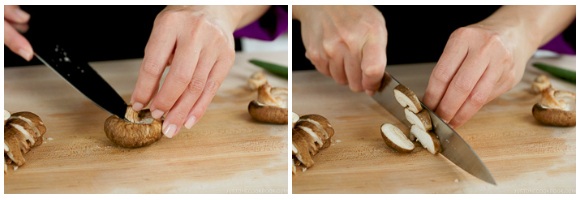
- Cut 2.5 oz carrot in half lengthwise and slice thinly. Cut 2 green onions/scallions thinly.

To Finish the Dashi
- Transfer the vegan kombu dashi to a soup pot or donabe. Slowly bring the kombu dashi to a boil over medium-low heat. When the water is almost boiling, remove the kombu to avoid sliminess. If you are vegan/vegetarian, skip the next two steps.

- Add 3 cups katsuobushi (dried bonito flakes) and cook for 15 seconds. Then, turn off the heat and let the katsuobushi steep in the pot for 15 minutes.
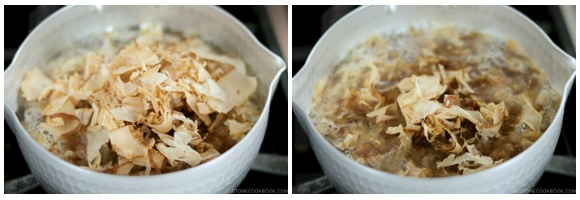
To Cook the Miso Soup
- Meanwhile, in a separate large pot (or donabe), heat 1 Tbsp toasted sesame oil over medium heat. Once the pot is hot, add the pork belly and stir to cook.
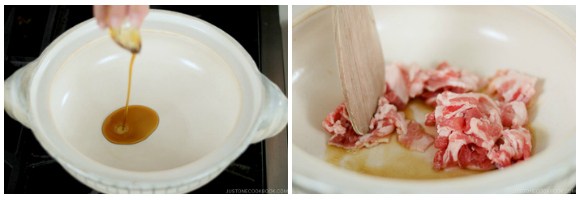
- Once the pork belly is 80% cooked through, add 1 Tbsp sake and stir to combine. Then, add the chopped leeks.
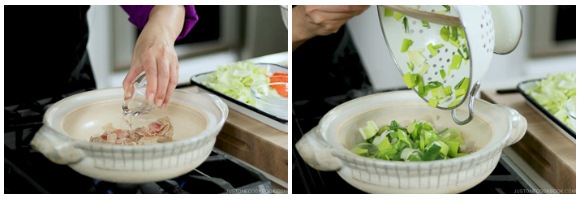
- Once the leeks are wilted, add the rest of the vegetables and mushrooms. Stir to coat with the oil. Using a fine-mesh strainer, strain the dashi into the pot (or add the dashi you made with dashi powder or a dashi packet).
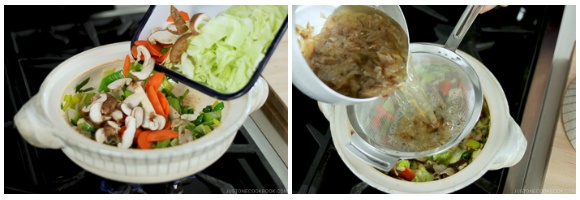
- Bring the soup mixture to a boil, skimming the foam and scum from the surface while cooking. Turn off the heat. Add half of the 4 Tbsp miso first, and then gradually add in more as you taste the soup. Each brand and type of miso tastes different and the sodium level varies, so you want to taste the soup before adding more miso.

- To the soup, add 14 oz soft/silken tofu (kinugoshi dofu), cut into cubes. Turn on the heat to continue to simmer until the tofu is warm (tofu is edible chilled, so you don’t have to worry about “cooking” it). Do not let the miso soup boil. It should take no more than 3–4 minutes to warm the tofu. The soup is now ready.
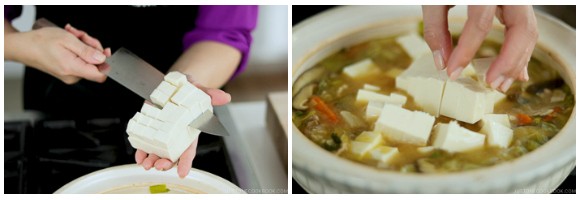
To Serve
- Before serving, scoop out a small portion of yuzu kosho (Japanese citrus chili paste) from the jar and place it on a small plate. Grind 2 Tbsp toasted white sesame seeds and put it in a small bowl. Serve them alongside the soup pot or donabe. After you ladle the soup into individual serving bowls, add a pinch of Yuzu Kosho, sprinkle some sesame seeds, stir in, and enjoy!

To Store
- You can keep the leftovers in an airtight container and store in the refrigerator for up to 3 days and in the freezer for 2 weeks.
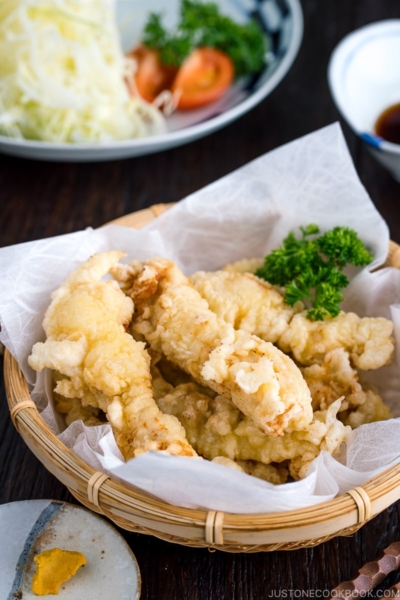
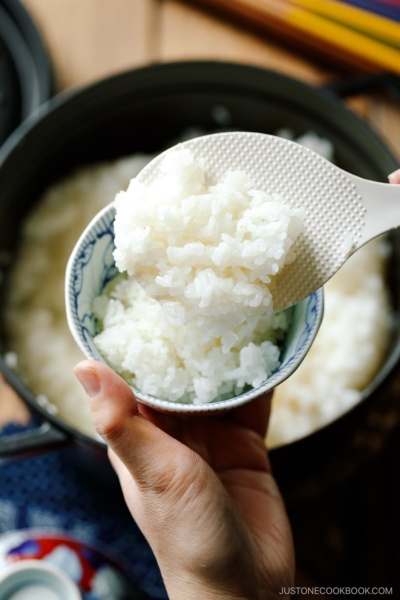
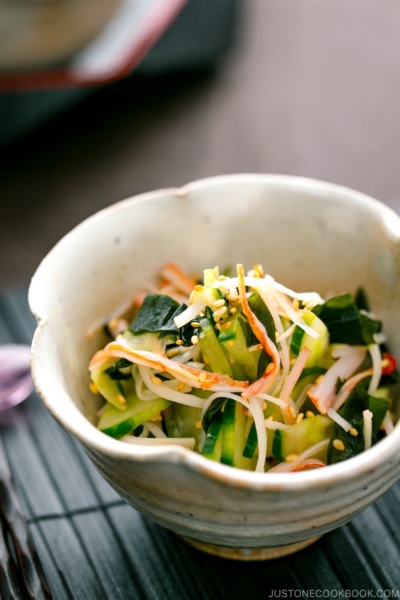
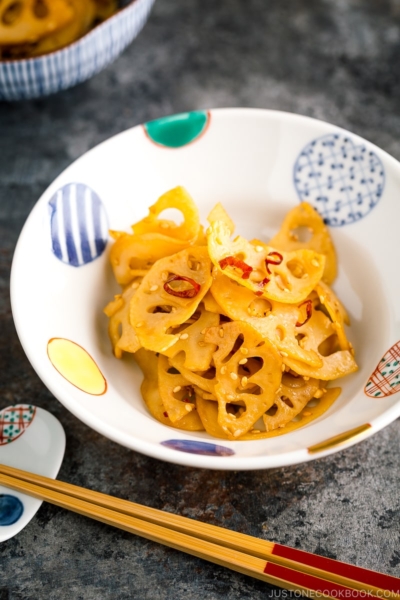




Love making this chunky miso soup! so hearty! my husband loves it too! never tried adding meat to a miso soup! Your video is a winner too! Thank you so much!
Hi Candace! I’m so happy to hear you liked the recipe and thank you for your kind words and feedback! 🙂
Hi,just made this dish.It was delicious,except I didn’t have yuzu koshu.I think I overcooked the pork belly.I will get the yuzu kosho.There is a Japanese store next to my job.Tomorrow I will cook pan fried ginger pork belly.Thanks for your recipes.
Hi Ramon! Thank you so much for trying this recipe! Yuzu kosho is a nice touch, but it’s one of the condiments that are really hard to find when you are outside of Japan. I’m lucky to live in a well-stocked Japanese grocery store. Hope you can find one in your local Japanese grocery store!
Nami,
First of all, your recipes ROCK!! I have tried many with pleasant results.
Now, are you using red or green yuzu kosho? I assume green (in picture). I use the green (just a touch) in the karaage marinade – nice spicy touch! I am a bento fan for work lunches. they are quite healthy and impress my co-workers. Its just an easy to make lunch for me.
Thanks for all the great recipes and meals.
Hi Alyx! Thank you so much for your kind words and for trying my recipes.
Yes, I’m using green yuzu kosho (green pepper ones). Really happy to hear you enjoy making (and eating) bento for your work lunch. I can imagine your co-workers drooling at your bento. 🙂
I’m drooling! I’m totally a soup-a-holic and this sounds amazing. I’ve heard of yuzu before but not this paste. I can imagine it would work so well in the soup.
Hi Sue! Yuzu kosho is quite addicting. Just a tiny paste goes a long way. Such an incredible condiment!
it’s overcast and raining here on Guam so I made this special miso soup. It is so delicious, hearty and perfect for this type of weather.
Thank you, Nami for sharing this amazingly delicious recipe!
Hi V! I’m so happy you gave this recipe a try! Thank you for your kind feedback. It’s definitely a great soup to enjoy on cold rainy day!
Thank you!!! This was so good, that I made it twice last month. There is something very grounding about the flavors and textures in this recipe, especially on cold winter evenings. And thanks for introducing me to yuzu kosho. It really gives the broth a nice, warm depth (just a teenie bit goes a long way). I can’t believe I had never heard of it before. I didn’t use the pork belly, but used shabu shabu slices of pork in its place. It was just right for me. Can’t wait to make it again.
Hi Joanne! I’m so happy to hear you enjoyed this recipe! Your feedback made me so happy. And I’m glad you could purchase yuzu kosho and give it a try! Isn’t it amazing? I really fell in love with miso soup with yuzu kosho in Kyushu. It’s a very memorable dish for me. 🙂 Thank you for your kind words!
Hi Nami,
If I am using instant dashi (by adding dashi powder to water), how many cups of it will I need for this recipe? Thanks!
Can’t wait to try this recipe. My hubby excitedly went to buy the yuzu kosho after reading about it!
Hi Bernice! For 4 cups water, use 2 tsp dashi powder. Hope your husband enjoys this recipe!
thank you. great recipes and teaching techniques.
Bless you!
Thank you so much, Susan!
Hi Nami, I made this miso soup with yuzu kosho last night with mixed results. The broth was wonderful, as were the veggies. I think I might have added a little too much yuzu kosho to my bowl, but I did get a sense of its essence and the citrusy umami flavor it added to the dish. My problem was with the pork belly. I have made a couple of your other recipes with pork belly in the past with great success. Unfortunately, last night it turned out really tough and although I’m sure the fat added some great flavor, my husband and I both found ourselves picking it out of our soup after getting a fatty mouthful once or twice. Do you have any tips? Maybe I sliced it too thick or the wrong direction? Was I supposed to put all of the fat into the soup after cooking it? Any suggestions would be welcome.
Thanks as always for the wonderful recipes. They remind me of the home cooking I experienced when I lived with a host family in Japan during high school for two years. I bought a donabe pot a few years ago and look for any chance to use it. Last night’s dinner was a great opportunity to pull it out again.
Hi Laurie! From what you wrote, it seems like the pork belly was too thick? My pork belly (I get from Japanese grocery store) is as thin as thin
cut bacon. I do not like that fatty pieces of pork belly, so if the pork belly I purchase happens to have lots of fat, I remove them…. it’s wasteful, but I do not like that rubbery fat, so all the white parts are discarded in my cooking. I keep some for flavoring though. Sorry it’s not the best advice, but pork belly pieces should be tender.
I’m glad you could use donabe for this recipe! It’s nice to have a fancy miso soup once in a while. 🙂
You’re just showing off with your gigantic suribachi. Now my wife wants a bigger one as well 🙂
How come you don’t use a miso strainer like this one https://www.amazon.com/Oxo-Stainless-Steel-Miso-Strainer/dp/B0001BDD20 Its a bit easier since you can hang it on the edge of the pot.
Great recipe by the way. Your website is the best.
Hi Angelo! AHAHAHA! I actually brought the suribachi back from Japan last summer as my family’s food doesn’t fit in my tiny suribachi I used to have. The bigger one makes it so much easier as I don’t have to pay attention to sesame seeds and just grind them freely (nothing overflow). Get one for your wife. 😉
I do use a miso strainer in my real life. Mine is from Japan (I probably brought back decades ago), and when I made a Shop page, OXO didn’t have a miso strainer so I never listed in my shop page! I’ll be adding to my list. Thanks for sharing the link with me. The reason why I didn’t use the strainer is that I don’t want people to know that we need a special tool to make a simple miso soup. I received that feedback from one reader, and I thought it made sense. 🙂
Thank you so much for following my blog and I’m SO HAPPY you like my site!
I have been following your instagram and blog for nearly two years and so far, this miso soup is my favorite — your video made it look delicious and so simple to prepare (it was both). I added extra cabbage because I didn’t have any carrots, and it tasted so good. I also did not have the yuzu kosho paste, but I used the yuzu kosho hot sauce from Trader Joes — which was fine, but I’m looking forward to trying it with the yuzu kosho paste. It was satisfying and made a great meal during our extended winter on the east coast. Thank you for all of your wonderful recipes.
Hi Luna! Thank you for following my IG and blog! I’m happy to hear you enjoy miso soup and enjoyed this recipe/video. 🙂
Ohhh that’s right Trader Joe’s yuzu kosho sauce! I forgot about that. That confirms that yuzu kosho is getting popular here (I have hope!). 🙂
Thank you for trying this recipe – the ingredients can be anything – and every time with different ingredient, miso soup tastes slightly differently. 🙂
Hello Nami
Thank.you for sharing this recipe about yuzu kosho
Recently i went to Donki.They sell yuzu kosho for $3-4.It looks cheap.However other jap supermarkets sell.it for about $8-9 like the one u showed in the picture.Since there is a big difference in price, is there also a difference in quality?
Tina
.
Hi Tina! Yes! I tried different yuzu kosho brands and taste is SIGNIFICANTLY different! Once you tried a really good one (like the one I showed in this post), it’s harder to go back… You don’t need a lot of yuzu kosho per meal – as you just use a little bit of paste at a time. The spicy kick, flavor, fragrance… quite different experience. You’ll know the difference in this case (some you may not notice the difference that much). 🙂
Hi Nami… very special recipe ..very excite..
i want to ask you something…
what is the different about yuzu and lemon….. ???
and do you know … homemade yuzu kosho..
Best regards…
Hi Chris! First of all, yuzu has the special fragrance that’s not very lemon like… it’s subtle, not sour like lemon (hence grapefruit/orange kinda sour level), and it’s very floral like smell and taste. Ah such a wonderful citrus that we should be able to get everywhere in the world…. 🙂
People in Kyushu make it from scratch where yuzu is abundant there when season. It’s pretty expensive to purchase yuzu (probably cheaper to purchase). I’ve never made it from scratch, but it’s mixture of salt, yuzu peel, and pureed chilis and leave it in a jar to ferment.
Thanks for this recipe Nami !! Although I do not think I can get yuzu kosho, I still find it interesting how a citrus fruit can combine with miso soup.
Also, these days I have seen several of your recipes and I have noticed that in some you simply mention dashi as an ingredient but in others you specify a quantity of water and katsuobushi to later do dashi. The latter has caused me curiosity and I would like to know why it is done this way.
Finally, if I can not find yuzu kosho, is there a substitute?
Finally, thanks for answering my comments in other post, I feel that I have become intense, I’m sorry
regards
Hi Ruth! If you’re in the US, you can purchase this on Amazon (https://amzn.to/2ilMDcG). It has citrusy flavor, but it’s more of salty and spicy taste that you enjoy. The recipes that include the ingredients/instructions for making dashi are relatively newer. These recipes probably have a video tutorial and in the tutorial, I explained how to make dashi. Unlike blog, it’s a bit harder to link to “dashi recipe” post or video on YouTube, so I have to explain in the recipe. Since I get step by step pictures from the videos, I explain the whole dashi process…. Hope I’m making sense? I basically keep it consistent for blog and youtube tutorial, and youtube requires making of dashi. Hope the extra dashi making process was okay in the blog post. No substitute for yuzu kosho. I’m sorry if you miss it, but I wanted to mention this condiment so everyone can learn about it and maybe one day when they hear about it, they know what it is already from reading about it on my blog many times. 🙂 Feel free to ask me anytime! I’ll be happy to help you and answer to your questions!
Hi Nami! Do you think adding a bit of lemon rind to the broth could add a similar citrusy punch? In any case I will try and let you know! Best, Ana
Hi Ana! That would be nice as well – similar effect as yuzu peel in miso soup.
Yuzu kosho gives citrusy, salty (quite salty, which is why only use a bit), and spicy taste all together. Very unique condiment. 🙂